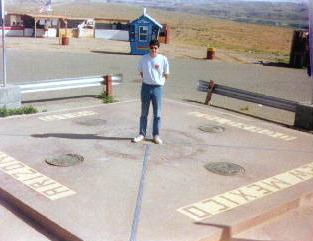
Four Corners is a unique spot in the United States. It’s the only U.S. location where four states join together with a common boundary – a quadripoint. Thus, a visitor can touch Arizona, Colorado, New Mexico and Arizona simultaneously.
Maps of the area show this situation clearly and anyone can get there by automobile with only a short detour. Thus it may be the most famous and commercialized piece of “strange geography” in the United States.
The Navajo Nation maintains the site and charges a nominal admission fee. Also, enterprising entrepreneurs sell a variety of Native American crafts at the site. They’ve created a ring of craft tables along the periphery of the monument.
Absolutely no logical reason exists to commemorate this barren patch of desert except for two artificially designated lines that happen to cross there.
… And yet I’m curiously drawn to it.
Updates
A couple of notes added after the original publication of this entry:
- I am aware of the controversy concerning the placement of the Four Corners supposedly at the “wrong” spot and the quick rebuttals of that claim. Regardless of the claims and counterclaims, surveyors established this spot and the government recognizes this as the point where four states intersect.
- There is also a 4-Corners in Canada, featured previously.
See also: my visit to the 4-Corners region in 2017.

Leave a Reply